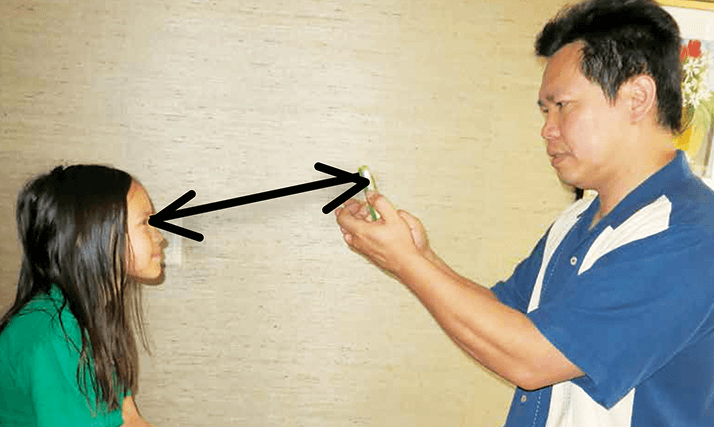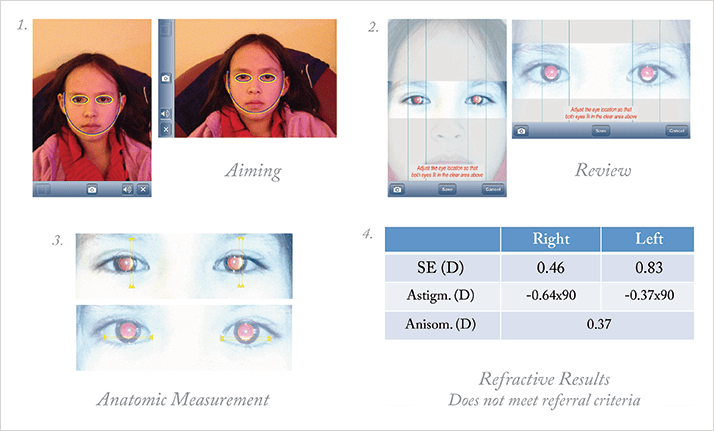
- Early detection of amblyopia in children results in good outcomes.
- Screening pre-school children is the best mechanism to do this.
- A number of factors have confounded universal preschool amblyopia screening
- A smartphone app, GoCheckKids, simplifies screening, at a fraction of the cost of alternatives.
In the first few years of life, the visual cortex undergoes intense development and reorganization in response to the signals coming down the optic nerve from the eye. It is known that there are “critical periods”, fixed intervals during early childhood development, during which these plastic changes in the brain occur. When these critical periods are complete, plasticity is greatly reduced.
In the first few years of life, the visual cortex undergoes intense development and reorganization in response to the signals coming down the optic nerve from the eye. It is known that there are “critical periods”, fixed intervals during early childhood development, during which these plastic changes in the brain occur. When these critical periods are complete, plasticity is greatly reduced. The detection of amblyopia, strabismus, and other vision disorders during the critical periods – before they result in permanent loss of visual acuity – is both possible and worthwhile. When the visual problems are corrected, the brain develops according to its normal schedule: the prognosis for reversing amblyopia is excellent at an age of three, more difficult at five, and almost impossible after a child is more than seven years old.
In the US, 2 to 3 percent of the population has amblyopia, rising to around 5 percent of low-income pre-school children. Overall, 15 percent of children aged 3 to 5 in the US have vision problems (primarily refractive errors) that could go on to threaten normal visual development if left untreated (1). The detection and treatment of these at-risk children is hampered by a wide variation in standards and resources: the approach varies from state to state, with many different organizations performing the screening in children at whatever age the state mandates. So, despite a consensus that it’s important to screen preschool children for amblyopic risk factors and other ocular diseases that need intervention, as recently as 2008, 60 percent of pre-kindergarten children in the US were unscreened (2). Of those who were screened, in only 14 percent was the procedure performed by the child's pediatirican (3). Things are beginning to change. In Oregon, where we live, legislation has been passed, mandating that all children who enter kindergarten have a vision-screening certificate. One technical impediment to vision screening in children is their poor comprehension of and cooperation with traditional testing with an eye chart. This is particularly difficult prior to the age of five years – just ask anyone who has first-hand experience. An alternative method that is appropriate even for very young children, which is based on an instrument that photographs the eyes and detects amblyopia and strabismus, has been developed. However, while instrument-based photoscreening has increased with key endorsements from professional societies in recent years (1), its use is still not widespread due to cost barriers and lack of awareness among healthcare providers.
Social factors also come in to play. Low-income families without access to regular pediatric care are far more likely to have children with amblyopia (and other ocular problems) that has gone undetected, eventually resulting in a large social and economic burden for society, and increased medical costs for the individuals and their families (4). The equipment for objective photo screening costs US$5000 or more, and this can represent a considerable barrier in rural or disadvantaged regions. There has been an unmet need for an inexpensive, portable device that can perform the screening.
There’s an app for that
A phone signal, a smartphone with a good camera and the right application are all that’s needed to allow almost anyone to detect amblyopia – and it is easier to master than learning how to play Angry Birds. GoCheckKids is that app and it has almost finished a development and clinical validation program. It compares standardized flash photographs taken in portrait and landscape orientations at a distance of three feet from the child you’re screening (Figure 1). At this distance, eyes with significant refractive errors have a bright crescent of retinal reflection that present in the pupil, according to the eccentric photo refraction principle. The GoCheckKids app measures refraction using crescent width, pupil diameter, and corneal diameter from the two photographs, and strabismus is measured by the position of corneal reflex relative to the pupil and cornea (Figure 2). All of this is hidden from the user – the computer in the smartphone analyses these parameters and returns its verdict almost instantaneously.
The app performs far better than distance charts and stereoacuity tests, which detect less than four in every 10 cases of amblyopia and can produce many false positive referrals (6). Early studies with GoCheckKids have shown sensitivity rates of 81 to 86 percent, with 91 to 100 percent specificity. These results, from a US$300 smartphone, are comparable to those of a US$5000 (or greater) dedicated photoscreening device (5, 6). After field tests of the app for two years at Oregon Health & Science University’s Elks Children’s Eye Clinic, follow-up Coordinator, Talitha Dale says that, “The new GoCheckKids smartphone application may provide a viable alternative to very expensive vision screening equipment, which would allow amblyopia screening to take place in pediatric offices or by staff at preschools or child care centers”. GoCheckKids has the potential to transform amblyopia screening. It is now up to healthcare systems in the state and around the world to consider how to implement it. If all it takes to screen a young child for amblyopia is two photographs on a smartphone, why wouldn’t you want to screen for amblyopia early?
Joannah Vaughan is the Program Director of Elks Children’s Eye Clinic preschool vision screening program at the Casey Eye Institute, Oregon Health and Science University, Portland, OR, USA, and David Huang is the Weeks Professor of Ophthalmic Research and Professor of Ophthalmology and Biomedical Engineering at Oregon Health & Science University.
Huang is a founder of Gobiquity, Inc., maker of GoCheckKids, and has financial interest in the company.
References
- S.P. Donahue, B. Arthur, N.E. Neely, et al., “POS Vision Screening Committee. Guidelines for automated preschool vision screening: A 10-year, evidence-based update”, J. AAPOS, 17, 4–8 (2013). doi: 10.1016/j.jaapos.2012.09.012. R.J. Klein, S.E. Proctor, M.A. Boudreault, K.M. Turczyn, “Healthy People 2010 Criteria for Data Suppression”, Hyattsville, MD: National Center for Health Statistics (2002). T.C. Wall, W.L. Marsh-Tootle, K. Crenshaw, et al., “Design of a randomized clinical trial to improve rates of amblyopia detection in preschool aged children in primary care settings”, Contemp. Clin. Trials, 32, 204–14 (2011). doi: 10.1016/j.cct.2010.10.009. J.S. Wittenborn, X. Zhang, C.W. Feagan, et al., “Vision Cost-Effectiveness Study Group. The economic burden of vision loss and eye disorders among the United States population younger than 40 years”, Ophthalmology, 120, 1728–1735 (2013). doi:10.1016/j.ophtha.2013.01.068. J.M. Vaughan, T. Dale, A. Choy, “Photoscreening for Refractive Error and Strabismus With a Smartphone App”, IOVS, 55, ARVO E-Abstract 436 (2014). R.W. Arnold, M.D. Armitage, “Performance of four new photoscreeners on pediatric patients with high risk amblyopia”, J. Pediatr. Ophthalmol. Strabismus, 51, 46–52 (2014). doi:10.3928/01913913-20131223-02.
